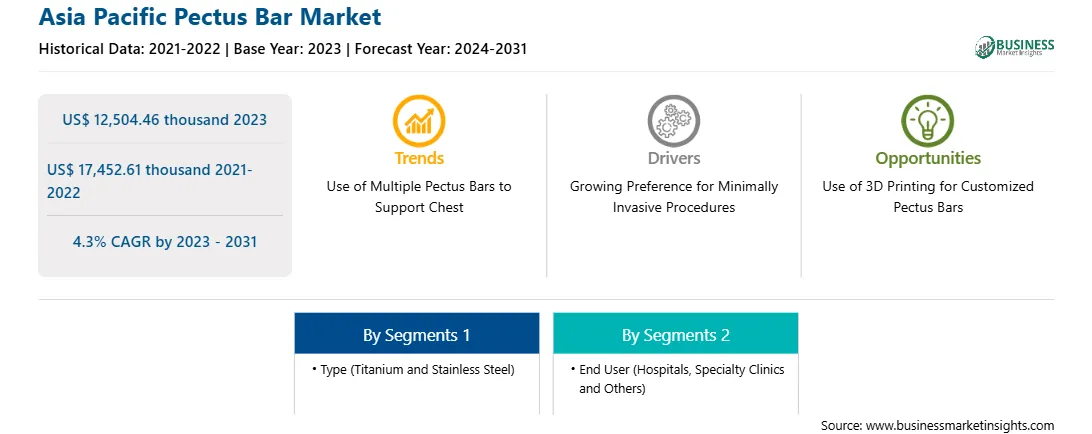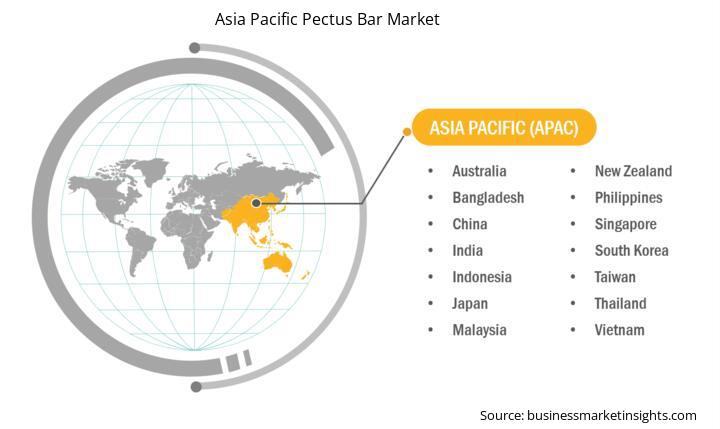The Asia Pacific pectus bar market was valued at US$ 12,504.46 thousand in 2023 and is expected to reach US$ 17,452.61 thousand by 2031; it is estimated to register a CAGR of 4.3% from 2023 to 2031.
Growing Preference for Minimally Invasive Procedures Boosts Asia Pacific Pectus Bar Market
Pectus excavatum, also known as sunken chest or funnel chest, is a result of abnormal growth of rib cartilage due to which the sternum is pulled inward, resulting in depression in the chest. According to Radiopaedia, pectus excavatum occurs in up to 1 in 300–1,000 births and is predominant in males. As per the National Library of Medicine (NLM), in 2023, about 95% of congenital chest wall anomalies are attributed to pectus deformities, and pectus excavatum is most common in them. To surgically repair pectus excavatum, pectus bars are placed in such a way that the sternum is repositioned, giving space for the heart and lungs to function properly. This procedure improves breathing, exercise intolerance, and chest pain in the patient. According to the study “The questionable benefit of pectus excavatum repair on cardiopulmonary function: a prospective study,” published on NLM in 2022, since the introduction of minimally invasive techniques for fixing pectus excavatum, there has been an increase in the number of patients opting for surgery for the treatment of pectus excavatum using pectus bars. Thus, the growing awareness about the benefits of pectus bar placement is driving the Asia Pacific pectus bar market growth.
Asia Pacific Pectus Bar Market Overview
China accounts for a major share of the pectus bar market in Asia Pacific, and the market in China is likely to experience moderate growth rate in the coming years. Advancements in surgical techniques, coupled with the surging awareness regarding chest wall deformities and developing healthcare infrastructure are among the noteworthy factors contributing to the market growth in China. The government has established a healthcare insurance system covering 96% of the population, which benefits more than 1.36 billion people in the country. As per the National Library of Health’s report published in 2023, the country had 9.4 million beds, 7.4 million hospitals, 1.7 million township-level health centers, and 0.3 million public health institutions as of 2021. Moreover, increasing awareness about chest wall deformities caused by hereditary conditions such as Marfan syndrome or congenital cardiac surgeries is expected to benefit the pectus bar market in the country. According to Intractable & Rare Diseases Research 2021, Marfan syndrome affects ~10 persons out of 100,000 of the Chinese population, causing chest wall deformity. According to a study published in the Journal of Cardiac Surgery in 2023, 10.9% of infants undergoing congenital cardiac surgeries through a median sternotomy developed thoracic deformities after the procedure. Thus, a surge in the number of cases of chest wall deformities and the developing healthcare infrastructure fuel the pectus bar market in China.
Asia Pacific Pectus Bar Market Revenue and Forecast to 2031 (US$ Thousand)
Strategic insights for the Asia Pacific Pectus Bar provides data-driven analysis of the industry landscape, including current trends, key players, and regional nuances. These insights offer actionable recommendations, enabling readers to differentiate themselves from competitors by identifying untapped segments or developing unique value propositions. Leveraging data analytics, these insights help industry players anticipate the market shifts, whether investors, manufacturers, or other stakeholders. A future-oriented perspective is essential, helping stakeholders anticipate market shifts and position themselves for long-term success in this dynamic region. Ultimately, effective strategic insights empower readers to make informed decisions that drive profitability and achieve their business objectives within the market. The geographic scope of the Asia Pacific Pectus Bar refers to the specific areas in which a business operates and competes. Understanding local distinctions, such as diverse consumer preferences (e.g., demand for specific plug types or battery backup durations), varying economic conditions, and regulatory environments, is crucial for tailoring strategies to specific markets. Businesses can expand their reach by identifying underserved areas or adapting their offerings to meet local demands. A clear market focus allows for more effective resource allocation, targeted marketing campaigns, and better positioning against local competitors, ultimately driving growth in those targeted areas.Asia Pacific Pectus Bar Strategic Insights

Asia Pacific Pectus Bar Report Scope
Report Attribute
Details
Market size in 2023
US$ 12,504.46 thousand
Market Size by 2031
US$ 17,452.61 thousand
Global CAGR (2023 - 2031)
4.3%
Historical Data
2021-2022
Forecast period
2024-2031
Segments Covered
By Type
By End User
Regions and Countries Covered
Asia Pacific
Market leaders and key company profiles
Asia Pacific Pectus Bar Regional Insights

Asia Pacific Pectus Bar Market Segmentation
The Asia Pacific pectus bar market is categorized into type, end user, and country.
Based on type, the Asia Pacific pectus bar market is bifurcated into titanium and stainless steel. The titanium segment held a larger market share in 2023.
In terms of end user, the Asia Pacific pectus bar market is segmented into hospitals, specialty clinics, and others. The hospitals segment held a larger market share in 2023.
By country, the Asia Pacific pectus bar market is segmented into China, India, Japan, Australia, South Korea, and the Rest of Asia Pacific. China dominated the Asia Pacific pectus bar market share in 2023.
KLS Martin Group, Biotech GmbH, Zimmer Biomet Holdings Inc, and Ventura Medical Technologies are some of the leading companies operating in the Asia Pacific pectus bar market.
The Asia Pacific Pectus Bar Market is valued at US$ 12,504.46 thousand in 2023, it is projected to reach US$ 17,452.61 thousand by 2031.
As per our report Asia Pacific Pectus Bar Market, the market size is valued at US$ 12,504.46 thousand in 2023, projecting it to reach US$ 17,452.61 thousand by 2031. This translates to a CAGR of approximately 4.3% during the forecast period.
The Asia Pacific Pectus Bar Market report typically cover these key segments-
The historic period, base year, and forecast period can vary slightly depending on the specific market research report. However, for the Asia Pacific Pectus Bar Market report:
The Asia Pacific Pectus Bar Market is populated by several key players, each contributing to its growth and innovation. Some of the major players include:
The Asia Pacific Pectus Bar Market report is valuable for diverse stakeholders, including:
Essentially, anyone involved in or considering involvement in the Asia Pacific Pectus Bar Market value chain can benefit from the information contained in a comprehensive market report.